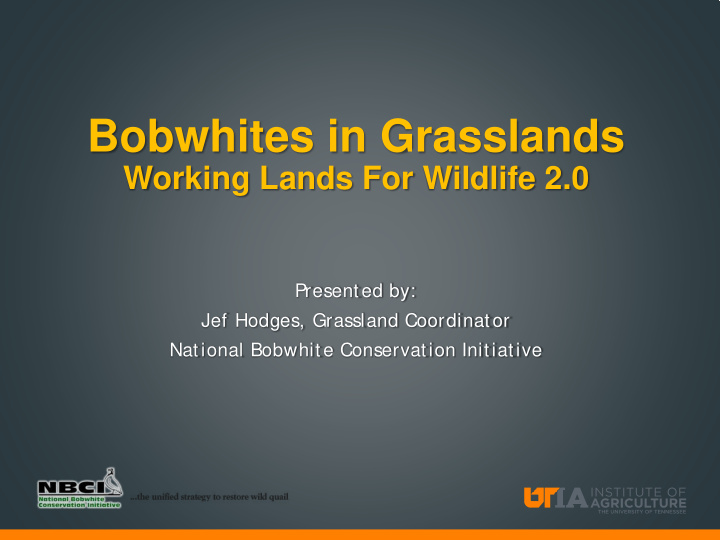



Bobwhites in Grasslands Working Lands For Wildlife 2.0 Presented by: Jef Hodges, Grassland Coordinator National Bobwhite Conservation Initiative
The States Have United for Bobwhites 1 Unified 1 Unified 25 States + Technical Committee Initiative Partners Midwest Southeast Northeast Many Partners
WLFW 2.0 Priority Landscapes
The “Working Lands” Objectives 1) Replace a portion of exotic forages, especially endophyte infected tall fescue, with native grasses and forbs; 2) Develop prescribed grazing plans that meet bobwhite habitat needs while applying appropriate utilization of native forage; and 3) S upport prescribed grazing and enhance bobwhite habitat through the use of supplemental practices.
Modified Knopf diagram relating grazing intensity, plant structure and bobwhite habitat niches.
Mostly Mostly increasers, Mostly invaders, Mostly Plant some decreasers, some increasers, Community increasers decreasers some increasers some invaders Bobwhite Poor nesting, S ome nesting, Good nesting, Excellent Habitat excellent good food some food nesting, poor food, food Fair Good Excellent Poor Rangeland condition class, dominant types of plants, and their value to bobwhites. From Beef, Brush and Bobwhites, Fernandez and Guthery.
“ It is important to understand that the structural elements of habitat (height, density, distribution) of herbaceous and woody vegetation are what largely drive bobwhite abundance.” Brennan, NBCI 2.0
Bobwhite Habitat Components Lack any one and you don’t have bobwhite habitat! • Nesting Habitat • Basketball-sized clumps of bunchgrass, 10-20% taller than other grasses, found at random. • Minimum 300 clumps, optimal density 600 – 700 clumps/ acre. • Brood Habitat • Rich in insects on or near ground. • Numerous patches of, or contiguous bare ground. • Overhead screening cover – predator avoidance. • Escape – Loafing Habitat (Protective Cover) • S hrubs or stiff stemmed forbs 3 – 10 feet tall, minimum 5 ft. canopy diameter – loafing; 20 ft. canopy diameter - escape. • Ideally 10 – 30% of landscape.
Some Basic Considerations • Nest predation increases with increased removal of vegetation. • Nest trampling not significant at 0.25 – 1.0 AU/ acre. • Odds of nest trampling increase over time. • Utilization < 65% has minimal effect on nesting passerines. Bobwhites : (NBCI CIP habitat classification key) • Vegetation height > 8” > 50% of the year. • 25 – 75% bare ground. • Protective cover within 164 ft. (50 m.) Other considerations: • Bobwhites nest April – S eptember. • Bobwhites need 40 – 45 days to complete nesting cycle. • Needs to be profitable for the cattleman. • High intensity-short duration grazing systems build soil health, increase grass vigor and promote greater biodiversity.
NestiNg cover
Bobwhite Population Trend 1966-2006 NBCI 2.0
Landscape Scale • Minimum 25% of landscape consisting of bobwhite habitat, with; • Minimum 1,500 acres bobwhite habitat.
Landscape Context “ There was a threshold of approximately 40% forest cover within 250 m (≈ 275 yds.) of a field, below which the probability of occupancy for eastern meadowlark, grasshopper sparrow, northern bobwhite, and red-winged blackbird declined.”
Landscape Context
Jef Hodges j hodge34@ utk.edu
Why Grazing for Bobwhite Habitat?
Focus Area Pilots Indian Creek, SC IA Mean Covey’s per Point Fall Covey Count 6 18 16 16 4 8 2 7 5 4 4 0 2006 2007 2008 2009 2010 2011 2012 2013 2014 2009 2010 2011 2012 2013 2014 2015 # Coveys Linear (# Coveys) Focal Area
Recommend
More recommend